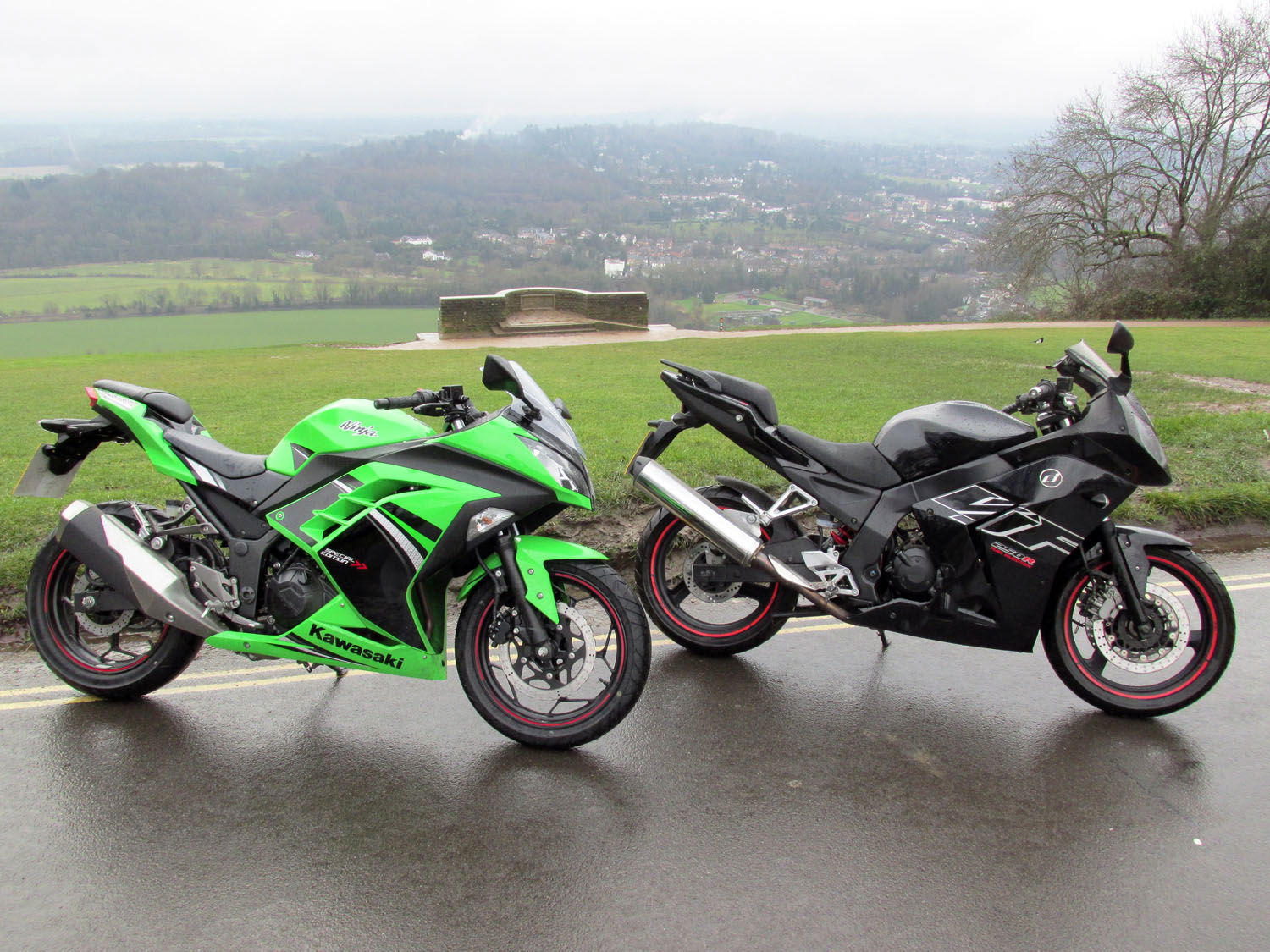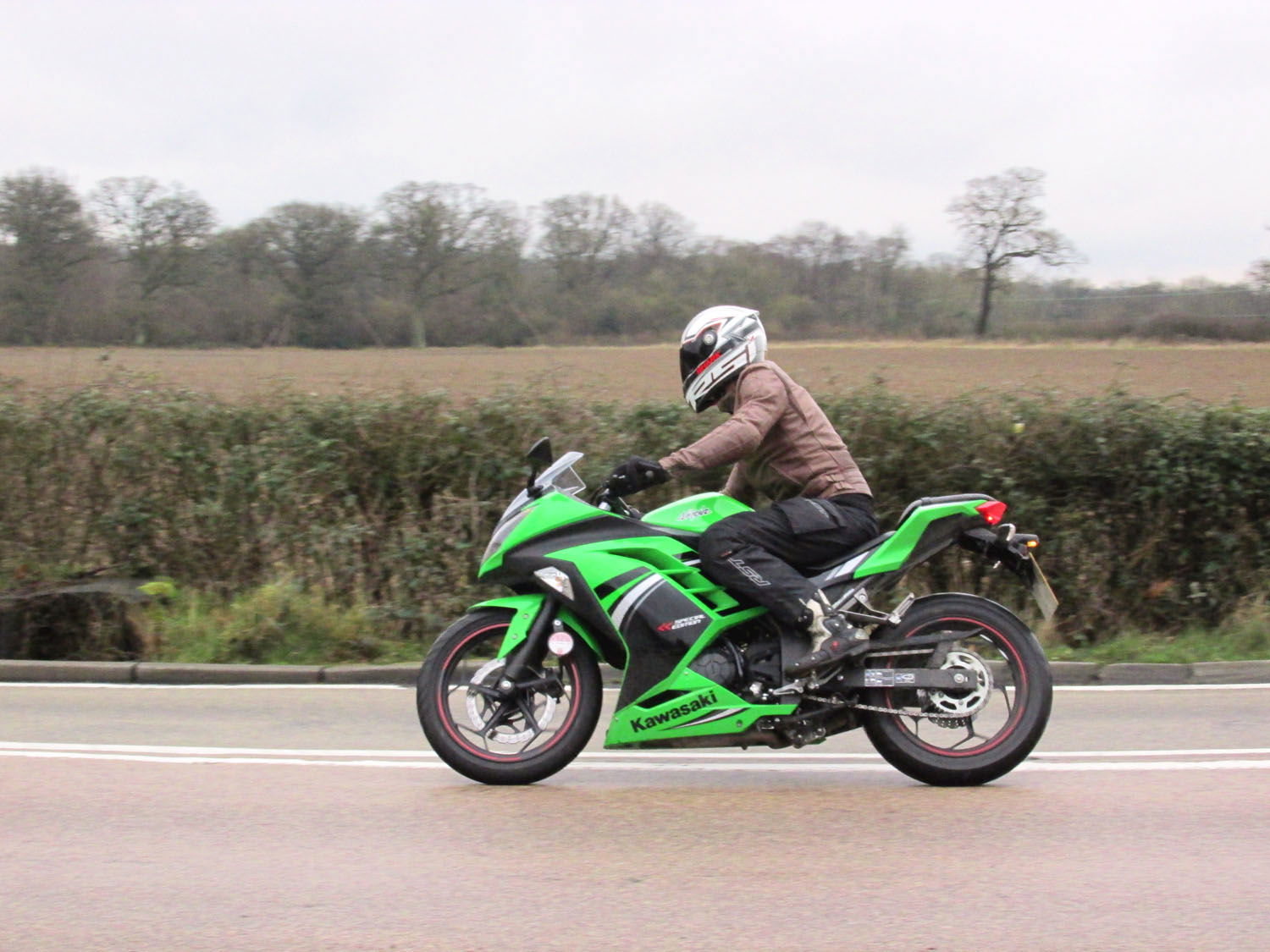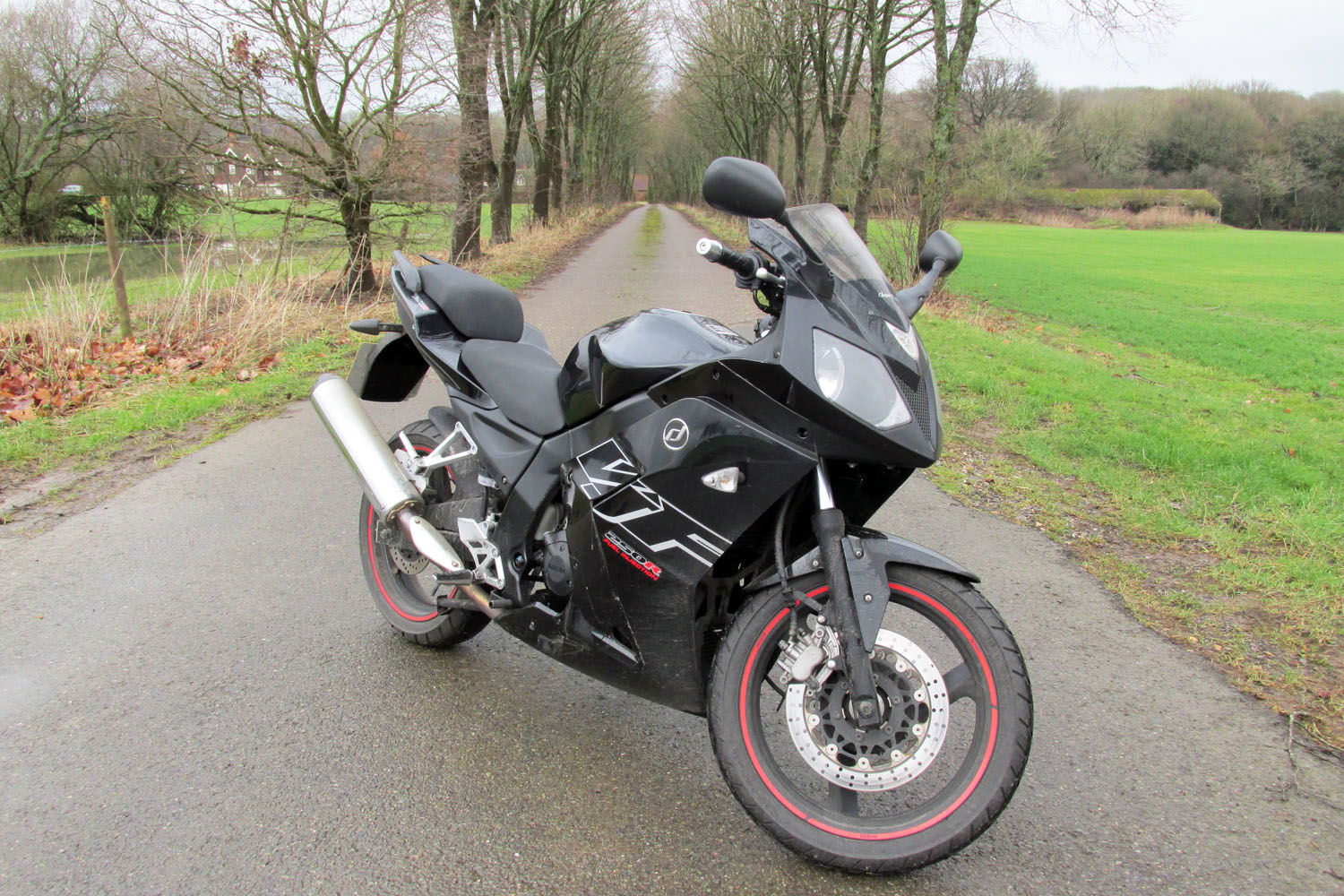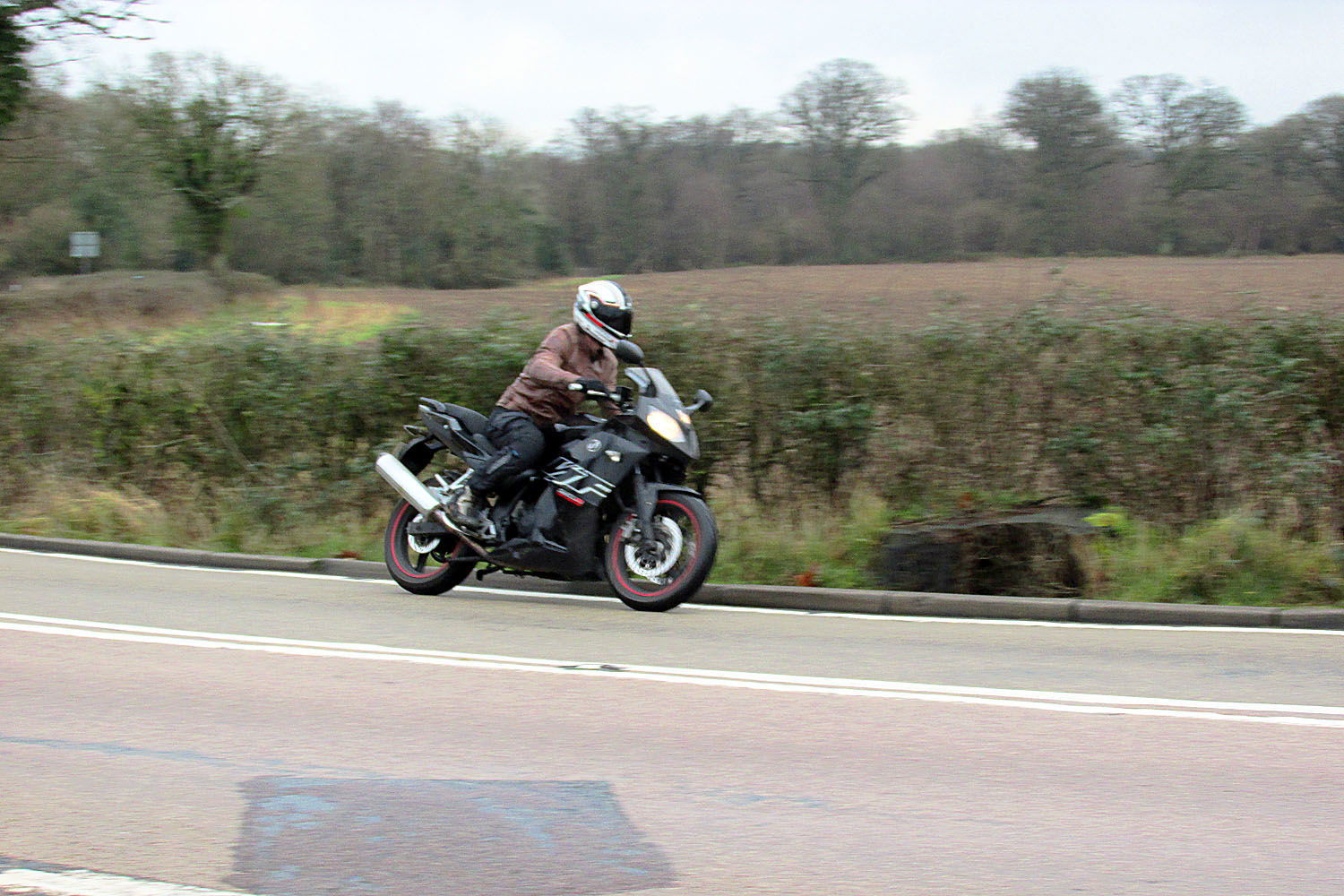Comparison test: Kawasaki Ninja 300 vs. Daelim VJF250 review
The Ninja 300 is a better performer. But does that make it a better buy?


IN TERMS of performance, this head-to-head is a foregone conclusion. At 39hp - 14 more than the VJF250 - the Ninja 300 is the faster bike. There you go, I spoiled it. Or perhaps after a quick glance at the spec sheet you’d guessed that already.
The question is, at £2,999, does the Korean-made VJF250 RoadSport offer a realistic and tempting alternative to the Ninja 300, which is £1,800 more expensive?
To the untrained eye, neither the VJF250 or Ninja give much away to suggest they’re low-capacity bikes. From the VJF’s twin-disc front brake to the Kawasaki’s authentic Ninja looks, both bikes do convincing impressions of bigger, faster machines. Gone are the days of feeling emasculated on a smaller bike. Maybe.
With Eurocrats chopping and changing motorcycle licence rules as they please, manufacturers are constantly playing catch-up with new laws and restrictions. That’s why Kawasaki last year increased the capacity of the Ninja from 249cc to 296cc. The Ninja 250R made 33hp, the old power limit for new licence holders. That limit rose to 48hp in January last year under new ‘A2’ licence rules – so Kawasaki rolled out the 39hp Ninja 300.
As opposed to simply boring-out the engine for more power, Kawasaki included an all-aluminium block, new crankcases, lighter pistons, a new head, and even an ‘Assist and Slipper Clutch’ (ASC).
The ASC gives the clutch a lighter pull at the lever and is there to stop the rear wheel from hopping and locking up during heavy downshifts. Despite provoking it on our road test, I never felt it engage. Whether that’s a testament to the non-intrusiveness of the unit or my lack of riding skills, I’m yet to find out. We’ll give Kawasaki the benefit of the doubt on this one though.
Setting off on the Ninja, the first noticeable thing is the riding position. If a hybrid riding position exists, this is it. The rear-sets are high and, well, rear-set. The bars are tall and flat, placing you in a half-sporty, half-commuter position. It’s not awful. It just takes getting used to.
Compared to the VJF250, with its very soft seat and upright ergonomics, the Ninja would be my second choice for any long-distance travelling.
Daelim’s VJF250 gets a fuel-injected 247cc single-cylinder engine that makes a claimed 23hp and 14ft.lb of torque. For 2014 it gets a small power hike to 25hp with torque remaining the same. Both the 2013 and 2014 variants use the same five-speed gearbox.
The Ninja 300 makes more torque across the rev range than the old Ninja 250, with noticeable improvements to the mid-range. There’s no compromise at the top-end though; the 300 will rev to 13,000rpm and has a power-band reminiscent of an old two-stroke. Above 8,000rpm, the motor is on song and pulls like a hyperactive dog with a heavy dislike for Ritalin.
The engine doesn’t feel stressed though. At an indicated 70mph in sixth gear, the silky smooth parallel-twin revs away happily at 7,500rpm, with more than enough left in reserve for overtakes. Shown a long straight, the Ninja 300 will hit an indicated 110mph.
Being a single-cylinder, the VJF250 naturally vibrates more than the Ninja. The exhaust puffs out a punchy staccato rhythm without being obnoxiously loud under acceleration. At 70mph, the Daelim sits in top gear at 9,000rpm, while the red line is at 11,000rpm. You wouldn’t want to keep it there all day, but the 250 doesn’t object to it and will nudge just over an indicated 100mph at top whack.
Despite the VJF250 being 14hp down on the Ninja, it was faster than expected. In a short acceleration test from 10mph to 70mph, it wasn’t left that far behind the more potent Kawasaki.
They’re efficient too. After covering exactly 100 miles of fast riding, motorway travel and commuting, we calculated the Ninja and VJF250 returned 68.5mpg and 70mpg respectively. Visordown has tested Honda’s CBR500R at 67.4mpg. Both the Kawasaki and Daelim were ridden more aggressively too - the CBR was used mostly for commuting.
The VJF’s front brake helps lend it a sense of ambition – it’s unusual to get twin discs on a budget lightweight. They provide plenty of power but initial bite seemed to fade in heavy rain. The rear brake is powerful too.
The Ninja gets dual-piston brakes, with calipers that look a bit undersized alongside the 290mm single front disc. Braking power is there, eventually, but the lever requires a firm pull and the set-up isn’t as strong as the VJF250’s.
Our Ninja test bike didn’t have ABS fitted but Kawasaki do offer it, as a £400 option. Considering the base model is already £4,799, I’d feel a little shortchanged. ABS is not yet listed as an option on the VJF250.
However, what the Ninja lacks in stopping power, it makes up for in handling. Riding around in less than favourable conditions, the chassis is nimble and poised, and the firm, non-adjustable suspension gives plenty of feedback from the front tyre. It’s precise and engaging and constantly spurs you on to explore its redline. Around a handling circuit, I suspect the Ninja would run rings around the VJF250. That’s not to shame the VJF250, but to praise the Ninja’s potential.
The suspension on the VJF250 is non-adjustable and comes with an extremely soft set-up. It gives adequate feedback and is a welcome addition when riding over inconsistent and pothole covered roads, but lends the bike no favours through corners and under braking, where it seesaws and wallows. The riding experience isn’t ruined, but don't expect sports bike precision. Think of this more as a workhorse machine, both comfortable and practical, with a centre-stand, fuel gauge, under-seat helmet lock and grab rails included.
Only small issues plague these bikes. On the Ninja, the placement of the exhaust - which makes it tricky not to catch your boot on it whilst riding - and the underpowered brakes let it down. The VJF250 gets an awkwardly positioned side-stand, making it hard to find without leaning the bike over and looking down.
The Daelim also has a luggage compartment under the pillion seat, but, oddly, to access it you have to remove a fiddly plastic panel rather than the seat itself. And all you find is a toolkit and a space barely big enough for a small disc lock.
But despite those minor niggles, I’m really rather fond of both bikes.
Unfortunately for the Ninja, much like the girl who chooses the most expensive meal on the menu, the price taints the whole experience and makes you wonder whether it’s worth it.
The Ninja is a brilliant motorcycle that offers a thrilling ride with minimal running costs, but at £4,799 for the base model, its market seems small. If you’re looking for a cheap-to-run, sporty lightweight, and willing to drop £5,000 on it, you’ll be extremely happy. But i’m worried for Kawasaki that not too many people are.
When you factor in ABS, the Ninja comes to £5,199 – £2,200 more than the VJF.
The ABS Ninja is £1,000 more than Honda’s CBR250R and only £100 less than the CBR500R, both of which have ABS as standard.
The Daelim may not have as much sporting potential but it’s a likeable bike with oodles of character. It filters through traffic nicely, it’s comfortable and comes with useful touches that Daelim would be forgiven for not including at the price, like that centre-stand.
Every new VJF250 now comes with £250 of riding gear included too (an Airoh Mathisse helmet, textile jacket and gloves) and a factory-backed two-year warranty. That alone has got to make it worth a test ride.
It’s enough to see it win this comparison test. Let’s be clear: the Ninja is more accomplished but too expensive; the VJF is the better buy.
Model tested: Kawasaki Ninja 300
Price: £4,799 (£5,199 with ABS)
Power: 39hp
Wet weight: 172kg
Torque: 19.9lbft
Seat height: 785mm
Colours: Green, Special Edition Green
------------------------------------------------------------------------------------
Model tested: Daelim VJF250
Price: £2,999
Power: 25hp
Dry weight: 158kg
Torque: 14lbft
Seat height: 780mm
Colours: Red, Black, White
Want more?
Versus: Honda CBR500R vs KTM Duke 390
Versus: Kawasaki Ninja 300 vs KTM Duke 200








